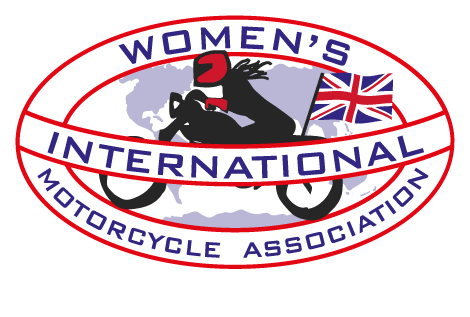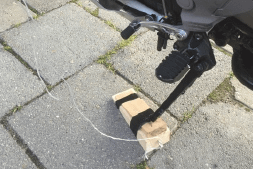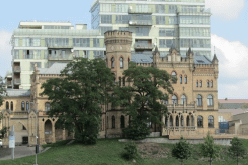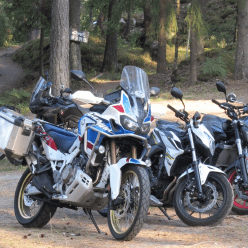
A fabulous trip; almost 2500 miles of road plus two ferry trips each way.
Having travelled across Europe last year to attend the WIMA Estonia International, this time I missed out Russia and spent more time in Latvia and Lithuania. What a mix across the EU of poverty, wealth, industry, agriculture and forestry but amongst all of that what wonderful, generous people I met along the way. There was fishing as well but mainly as the end product – delicious meals.
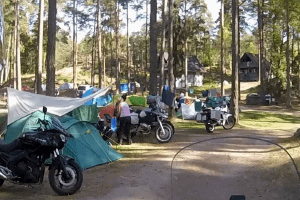
Lately, I have rediscovered the A68 running down the spine of North UK from Edinburgh to the A1 at Darlington. It does not take much longer than the alternatives of the A1 all the way along the coast from Edinburgh or the recommended fast route of A9 to Glasgow, M74 to Penrith, A66 to Scotch Corner then A1 south. The A68 is a pleasant road for most of it’s distance with lovely twisty sections, fine views and little traffic.
In April of this year I found the bike that I had been looking for several years – a single or twin cylinder, good sized fuel tank and luggage capacity. I had tried the BMW1200GS which was ok but does not have a very large tank; the larger explorer version is just too big and heavy for me. I actually did the deal for this new bike on 31st March so I got a really good part exchange package with my GS and Honda VFR 1200 for a brand new Honda Africa Twin Adventure which has a 350 mile capacity tank but a seat height of 900mm which is 50mm more than the standard Africa Twin and a bit too high for me. The Honda dealer recommended a Metisse 30mm lowering kit which was duly fitted. The problem was that the side stand then needed to be shortened as well and because it is aluminium, requires a specialist welder to cut out a piece and join the ends.
Bare with me – there is a point to this diversion.
Getting off the ferry in Zebrugge I stopped just beyond border control to check my bike, sat nav. etc was all in order. At this point the weld failed and I struggled to keep my fully loaded bike upright and wheeled to a wall that I could lean it against. I am assuming that the tying down of the bike on the ferry probably played a part in the side stand breaking.
The AA said that someone would come out but that took over 2 hours and in the meantime, a helpful P&O member of staff helped me contact the local Honda dealer in Zeebrugge. The AA man turned up prepared to jump the battery, not help with a broken side stand so he provided no assistance at all.
I managed to get to the local dealer but he took one look, shook his head and said that he could not weld it and that it would take him 48 hours to get a new Adventure stand (which was not what I needed).
I made it to my first overnight stop 318 miles away at Bad Nenndorf in Germany and parked the bike up against a wall. Over a beer or two that evening, I got talking (mainly via Google translate for the technical parts) to two men, one of whom was a pipe installer and the other a metallurgist both of whom worked for a firm designing and installing waste incinerators with steam turbines to produce electricity. They were proud to tell me that they had installed one plant in Falkirk, Scotland. They both looked at the broken part, which I just happened to have in my bag and announced that the manufacturing process of the side stand meant that the part was very strong but could not be successfully welded.
Next day I was off to the local equivalent of B&Q to purchase some wood, tape, screws and string and set-to in their car park, to make a peg-leg for my bike. You may laugh – I did – but it worked. I could stop, lower the peg-leg on the string and manoeuvre it under the broken side stand. I was concerned though about using my Heath Robinson handwork on the Tallinn to Helsinki Ferry, so phoned my local, Aberdeen Honda dealer. I wanted to know the part number and availability of the side stand for the standard Africa Twin, the difference in lengths and whether the fixings were the same for both. I received a full reply the following day – the difference in length is 2cm and the fitting is the same.
That night, I stayed in the first hotel that I could once over the border into Poland, at a place called Boczów. The bedroom was clean, the food local and very wholesome, the beer was good, thankfully as the choice of drink was water, coffee or beer. This was a fascinating place frequented by long distance van drivers so it was both cheap and good value. Here I spoke for a while with a man travelling from Slovenia to Germany, he had been educated in Edinburgh and now worked for the German Naval Shipyards in Wilhelmshaven; a place I had visited on my way to the WIMA Swedish Rally in 2015.
Armed with the new information from Ecosse Honda in Aberdeen, I visited the Honda dealer at my next overnight stop which was in Warsaw, fully expecting to have to wait up to 48 hours to get the part. They were not convinced that what I wanted was practical or would even work but after much discussion between themselves and the workshop manager they agreed to put a side stand for a standard bike onto my adventure version, as long as I was prepared to pay even if it did not work.
Better still, they had the part in stock. Other work was stopped and they wheeled my bike in to the workshop where the whole thing was done in 30 minutes. It works perfectly.
I was back on the road just an hour and half later than I had originally planned. I was and still am, very impressed with Honda’s European Network.
My next move though was foolish on my part, in order to make up time I set my Sat Nav for a quick route to my next stop in a place called Druskininkai in Lithuania; one of the volunteer advisers in my place of work had recommended it to me when she heard that I was going to her home country. Unfortunately, I forgot that I had originally planned my route to go around Belarus. I was well aware that I had 2 rainbow flags in my luggage which may have been used against me if found by border guards in either Russia or Belarus.
I had a more immediate problem though, travelling north on the main road through Poland, each petrol station in a very long section was closed. I started looking for a stop when my instruments said I had 50 miles of fuel to go but by the time I got to 20, I was becoming quite concerned so I turned off the main road to set my satnav to the closest filling station. At the point where I was being told that I had 14 miles worth of fuel left, the engine stuttered then died. I cruised to a halt beside a team of workmen laying drains. We looked at each other then, using sign language and pointing, the foreman instructed me to go with a worker in their van to get petrol. This was from an agricultural supplier in a tiny village about 6 kilometres away. As with most places, they sold beer but the driver would not accept any from me for his effort. Having purchased a petrol can and 5 litres of fuel it was back to my bike where I had left it. I offered money as thanks but he politely and firmly said no. What lovely people, in the middle of nowhere, taking time to help a foolish old woman who ran out of petrol.
Fully fuelled up again, I followed the satnav, noting that the roads were getting quieter and more rural, it finally dawned on me that I could be heading for Belarus. It is worth noting that the gap between Kaliningrad and Belarus is less than 50 miles, with only one main road and several smaller roads going from Poland to Lithuania.
TomTom was sending me down gravel roads or eastwards towards the border; I was assum-ing that each crossing point would be guarded but did not want to take that risk as I worked out that I was very close to it. I stopped at the side of a road in a tiny village to check my posi-tion when a voice called out from the nearest house and a big man with oily hands came out to see if I needed help. He told me to stay put and went next door to get his sister who spoke very good English. He produced a map and assured me that if I followed their instructions I would get to my destination without attempting to cross the border. He even gave me his large scale map of the area.
Amusingly, their instructions sent me down the same gravel roads that my sat nav wanted me to use, which was clearly normal for them though they did say that there was one bad section – they were not wrong.
Eventually I turned up at the hotel I had pre-booked in Druskininkai. The Hotel Dainava looked as though it dated from communist times, very square and formal. Dinner was be-tween 6:00 and 7:00pm so I was 2 hours late. The town is a spa town and full of tourists and visitors to the spa, the hotel itself though was part hotel, part sanatorium with the whole ground floor dedicated to an assortment of treatment rooms, mainly involving water. It was quiet in the evening but next morning the corridor was full of people, mainly infirm and in various states of undress or people wearing doctors coats or nurses uniforms. There were zimmers, walking frames and wheelchairs all over the place, almost like an obstacle course. I felt very sorry for these people, many of whom were distressed and hoping (and presumably paying) for some magical cure for their ailments. It put our own free NHS service into perspective. It reminded me of hundreds of poor, desperate people I had witnessed paying (and praying) for miracle cures by crawling around the church at São Bento da Porta Aberta, in Portugal where I stayed overnight several years ago on a trip to Los Picos in Spain and to the Algarve.
Next morning was just a short run up to Vilnius where a man in a 4×4 actually pushed me out of the way with his car bumper as he tried to squeeze into a small parking space between where I was parked and a parked car. He eventually moved down three spaces to one of the several empty parking slots but only when he realised that he couldn’t get his car door open. This and other aggressive driving manoeu-vres have made me change my mind about Latvian’s being the worst drivers – Lithuanians are even worse.
I stayed that night in a lovely small hotel just this side of the Latvia/Estonia border, in fact the border dissects the village across the main street. The room was very clean and comfort-able, the food delicious and with good beer and wine, made for a most enjoyable rest. I find that people in most Baltic countries do not smile a lot – they probably have very good cause but they are friendly and talkative. The barman just wanted to chat to me about when he came to Birmingham despite the fact that he was struggling to speak and understand English.
In the morning, the owner’s son asked if I would take a picture on his camera of him and my bike together. He was just a young chap still at school but he has three bikes including a sin-gle cylinder Husqvarna that he uses for off-roading and is a member of a local motorcycle club. We chatted about bikes for 15 minutes before I set off.
I am always so impressed how good other people are at languages compared to me. I won-der how long people will continue to want to learn to speak English after we leave the EU in March next year.
The daytime temperatures had risen to 39 degrees as I rode through Germany, at last they were dropping to a more respectable 32 as I moved northwards.
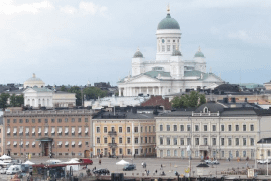
The ferry is not cheap considering that it is only 2 hours but everything is more expensive in Finland – and Estonia is not much better, in my opinion.
So eventually I arrived at the rally site in Parainen at 6:00pm, tired, hungry and very hot. My accommodation in a chalet fell through so I spent the next six nights in a borrowed tent and sleeping bag, sleeping on a mat that would not stay inflated. Fortunately, the carpet of warm pine needles was reasonably comfortable and the trees provided shade from the heat.
Next month, more about the excellent rally and my journey home.
Zara.
